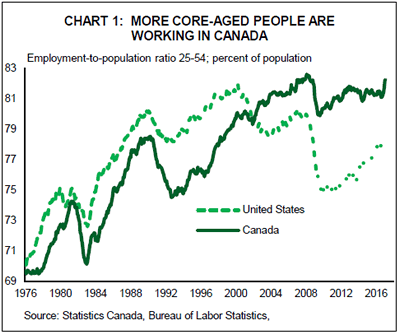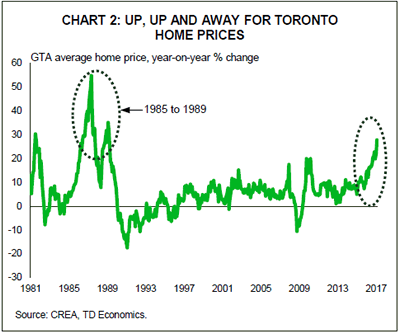HIGHLIGHTS OF THE WEEK
United States
- The Fed carried out its well-telegraphed rate hike this week. Despite the Fed’s hawkish messaging in advance of the decision, its expectations for rate increases were unchanged, leading bond yields to dip.
- The Fed edged up its economic forecast for 2018, as did TD Economics in our latest forecast, released this week.
- Overseas, one populist threat to the Eurozone was vanquished this week as the populist right-wing party lost the Dutch election. However, the UK is days away from triggering the two-year Brexit negotiation process with the EU, so the risk of euro-driven market volatility remains.
Canada
- Economic growth in Canada continues to surpass expectations. With recent data on manufacturing sales, growth in the first quarter appears likely to surpass our recent forecast of 2.6% (annualized). This would mark the third straight quarter that growth came in above 2.5%.
- The Canadian housing market is the gift that keeps on giving. The further prices and sales appear to move from fundamentals, the bigger the risk of a correction. The downside risk is greatest in the Greater Toronto Area where prices are up 24% year-on-year.
- To deal with housing, the Bank of Canada prefers macro-prudential tools to the blunt instrument of interest rate policy. With scant inflation, the central bank is likely to remain on hold through 2018. While further upside surprises to growth could pull rate hikes forward, a sharper turn negative in housing could just as easily push rate hikes even further into the future.
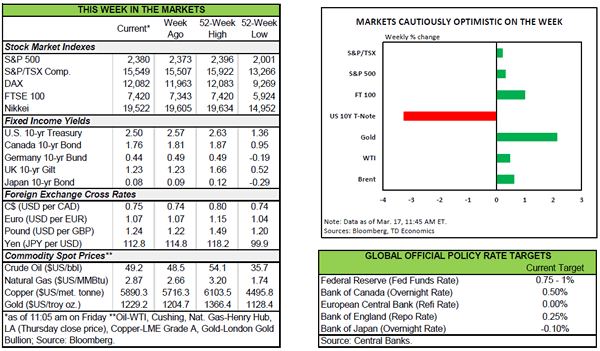
UNITED STATES – THE FED TAKES ANOTHER STEP ON THE RATE HIKE TIGHTROPE
Markets were cautiously optimistic this week as the Fed carried out its well-telegraphed rate hike, and one populist threat to the euro zone was vanquished in the Dutch election. The Fed hiked the funds rate 25 basis points, to a range between 0.75% and 1.0%. Bonds rallied in the wake of the decision, since the hawkish rhetoric leading up to the decision was not born out in a more aggressive pace of rate hikes in the Fed’s "dot" plot. The Fed continues to expect to raise rates three times in total in 2017, unchanged from its December forecast. Even with a dip downwards in yields this week, the 5-Year Treasury yield remains close to a sixyear high(see Chart).
During the press conference, Yellen characterized the economy as "progressing nicely", and that the Fed views three hikes per year as a "gradual" pace in the current environment. While the median interest rate projection remained unchanged, the number of dots at the median rose (from six to nine). The Fed’s economic projections told a similar story, edging up by 0.1 percentage point its outlook for core inflation in 2017 and its outlook for economic growth in 2018. In other words, FOMC members are a bit more confident, but no more hawkish, than they were in December.
The Fed was not alone in nudging up its forecast. In our latest economic forecast released this week, we also bumped up our forecast for growth in 2018. The upgrade is largely owing to a more optimistic forecast for domestic demand, and business investment in particular. Measures of business sentiment have largely held on to their post-election jumps, and we expect that optimism will translate into increased spending over the next two years. Particularly now that the weakness in corporate profits appears to have turned around, and the worst is over in the oil patch.
As always, there are upside and downside risks to the outlook. The most notable upside risk stems from fiscal policy. We continue to believe it is too early to include any potential boost from the kinds of tax cuts or infrastructure spending that was promised during the campaign. As evidenced by the current debate on healthcare reform, it is going to take time for Republican members of Congress and the White House to reach an acceptable compromise on these key policy priorities. Therefore, we expect any fiscal boost to be a factor in the 2018 outlook and beyond, not this year.
Like the Fed, we also expect a gradual pace of rate hikes this year. Downside risks to the forecast have not entirely vanished. Concerns stemming from political uncertainty in Europe did clear one hurdle this week with the Dutch election result. But, France’s Presidential elections loom (on April 23rd and May 7), and the UK is on the cusp of triggering two years of Brexit negotiations with the EU. The potential for euro-driven market volatility to disturb markets’ current placid optimism is real. And on this side of the pond, the risk that the Trump administration moves from rhetoric to real protectionist measures on trade also looms.
Taking a step back to the here and now, the U.S. economy is doing well. The Fed must now walk a tightrope balancing the need to remove monetary stimulus against the risk of taking rates too high, which would dampen domestic growth too much or trigger risks abroad.
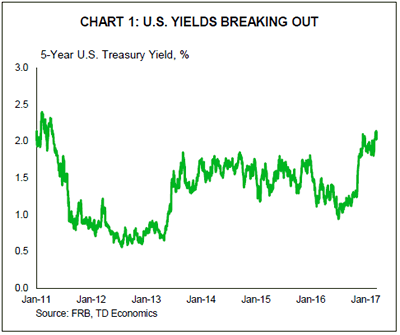
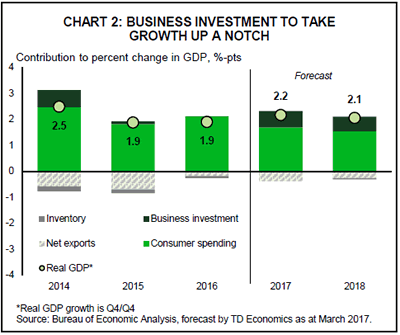
CANADA – LET THE GOOD TIMES ROLL
Economic growth in Canada continues to surpass expectations. With recent data on manufacturing sales, growth in the first quarter of this year appears likely to surpass our recent forecast of 2.6% (annualized). This would mark the third quarter that growth came in above the mid-2% mark.
The strong economic performance has been echoed in robust job creation, falling unemployment and rebounding labor force participation. In February, the unemployment rate fell to 6.6% (from 6.8%), while the employmentto- population ratio of prime working-age people (those between 25 and 54) rose to its highest level since the 2008 recession (Chart 1). Even the seeming turn toward part-time employment that characterized 2016, appears to be reversing. Full-time job creation over the past three months is running at the fastest rate in over seven years.
The rebound in growth is explained in large part by the recovery in the oil patch, where the turn-up in energy prices has helped. Our recently published forecast expects the oil and gas sector to lead economic growth over the next year. Following close behind is the construction sector, benefiting from the energy rebound as well as residential real estate activity that continues to push full-steam ahead.
And here in lies the rub. The housing market has been the gift that keeps on giving, but there are legitimate worries about how long this can be sustained. The further prices and sales appear to move away from fundamentals, the more pronounced the risk of a correction (Chart 2). The downside risk is greatest in the Greater Toronto Area where prices are up 24% year-on-year, amidst low inventories. One need not go out on a limb to say this appears excessive. Even with strong population growth, sales relative to population have pushed above historic levels.
The vulnerability to housing correction is the main source of downside risk to the Canadian economy. Periods of such rapid appreciation are generally followed by corrections. However, in the near-term, without a major catalyst, the housing market appears likely to keep on chugging. Higher mortgage rates and tighter regulations have so far appeared to have little effect on the market, and further increases may also be taken in stride given their likely gradual pace.
All of this brings into question how the Bank of Canada should respond. In terms of housing, the Bank has been consistent that it prefers macro-prudential tools to the blunt instrument of the overnight rate. Instead the Bank’s policy will be guided with reference to the outlook for inflation. And, apart from rebounding energy prices, inflation pressures appear scant. The average of the Bank of Canada’s trio of core inflation measures is sitting at 1.6% – well shy of target.
At the same time, the Bank has expressed increasing concern for external risks. Given this sensitivity and its desire to support a rotation toward exports, which relies on a competitive exchange rate, we expect the Bank of Canada to remain on hold through the this year and well into 2018. While further upside surprises to economic growth could pull this forward, a sharper correction in the housing market could just as easily push rate hikes even further into the future.
